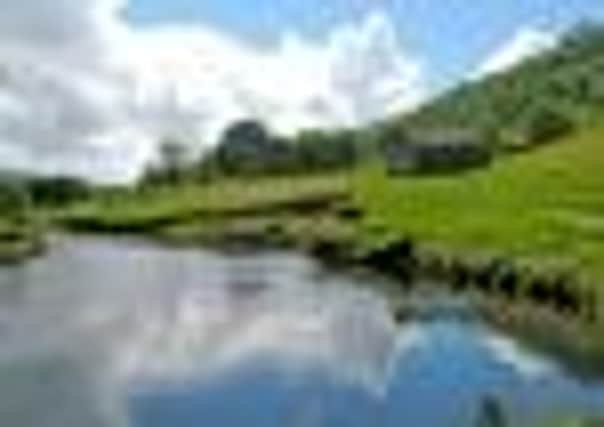A colourful way to follow in the steps of a Dales’ classic


The art of walking books has come a long way in the last decade.
My own guide to the Yorkshire Wolds Way, first published in 1982, was a pretty plain affair compared with the updated modern edition with its superior maps, photos and vignettes of special route features.
Advertisement
Hide AdAdvertisement
Hide AdAnd now one of the best of the entire walking guide genre, The Dales Way, has metamorphosed into a colourful handbook.
Today’s walkers demand less of a continuous narrative to a footpath, with precise stile-by-stile directions. Instead, they prefer a guide with information and graphics that leap off the page.
They want something that not only helps them find a faint path over a barren hillside but also a book they can enjoy reading at home before setting off, or while soaking in a bath at the b & b after a long day’s hike.
Colin Speakman’s first crack at writing a guide to the 78-mile long-distance walk, from Ilkley in Wharfedale to Bowness-on-Windermere, resulted in one of the old-style books when published by The Dalesman in 1970.
Advertisement
Hide AdAdvertisement
Hide AdPrinting costs then were high, and profit margins small. Full-colour maps were out of the question and attractive page designs would have made the book a luxury item which people would have been loath to take out in the mud and rain.
The exception to this, of course, was the series of pictorial guides produced by Alfred Wainwright, but lesser mortals had their walking guides typeset commercially and printed as slabs of text broken up with the odd black and white photograph.
However, the desktop publishing technology which first appeared in the late 1980s has changed all that, making it both technically and economically possible to produce beautiful books.
And Colin Speakman’s new Dales Way guidebook certainly fits that description. Maps, photos and sketches abound, with very few of its 112 pages looking identical.
Advertisement
Hide AdAdvertisement
Hide AdThe original Dalesman book went through nine different editions, mainly to update minor route changes, but the style of the book hardly changed.
The last one appeared in 2002, and since then the publishers had made it clear they were unlikely to bring out a new edition.
The Dales Way makeover is the work of new Yorkshire walking guide publishers Skyware, run from Saltaire by the husband-and-wife team of Tony and Chris Grogan, but the book is very firmly rooted in Colin’s original.
Cleverly, the route is described both in text and in map annotations, reducing the chances of walkers wandering off the path.
Advertisement
Hide AdAdvertisement
Hide AdAnd there are pen portraits of towns and villages and small articles on historical features encountered along the way. A nice touch is the reproduction of the route-at-a-glance graphic from the original 1970 edition.
Since few people know more about the Dales than Colin, being the author of 50 walking books on the area and current chairman of the Yorkshire Dales Society, it is hard to imagine a more informed guidebook to the walk.
He was also, of course, the route’s principal creator – one of a small and illustrious group who will always be associated with a long-distance path. Wainwright (the Coast to Coast) and Tom Stephenson (the Pennine Way) are fellow members.
In 1968, the Countryside Act gave local councils new powers to create public access on riversides, and Colin, then a leading figure in the West Riding Area of the Ramblers Association, and fellow walker Tom Wilcock, had the idea for a route that would follow the River Wharfe from Ilkley right up to its source on Cam Fell.
Advertisement
Hide AdAdvertisement
Hide AdBut the boggy wastelands high on the east-west watershed seemed like an anti-climax to such a fine walk.
So it was decided to continue the route down into Dentdale and, having got as far as Sedbergh, take it further west to a dramatic conclusion on the shore of Windermere.
There was a pioneering walk of the basic route by some venture scouts from Bradford Grammar School in 1969, after which Colin and his wife, Fleur, did the first detailed survey of the footpath that tens of thousands of walkers know today.
That summer, still lacking official blessing from the Government’s Countryside Commission and with 10 per cent of the route not on existing rights of way, the Ramblers Association nevertheless launched the Dales Way with a public walk between Ilkley and Bolton Abbey.
Advertisement
Hide AdAdvertisement
Hide AdUrgent amendments soon became obvious, particularly on the first leg of the route between Addingham and Bolton Bridge, where a field path was negotiated to take walkers off a busy stretch of the B6160.
Later, another stretch of tarmac was bypassed with the creation of a new section in Dentdale, and there are hopes that yet one more minor amendment will be made there by offering walkers an alternative route along the new Pennine Bridleway.
Extensions have also been added to it, notably from Woodhouse Moor, in Leeds, and another from Bradford.
In his introduction to the new edition, Colin writes: “Unique among UK long-distance paths, it leads from the centre of two major cities into two national parks, by continuous waymarked footpath.”
The Dales Way is, he says, truly “The People’s Path”.
Advertisement
Hide AdAdvertisement
Hide Ad• The Dales Way by Colin Speakman is published on March 1 by Skyware, £9.99. It is available at bookshops or can be purchased post free from www.skyware.co.uk
Roger Ratcliffe is author of the Yorkshire Wolds Way published by Aurum Press, £12.99.